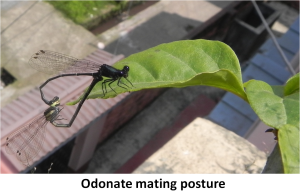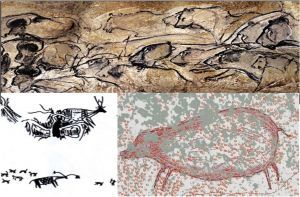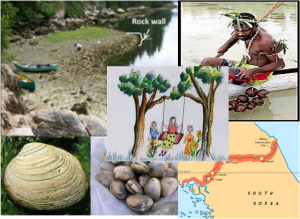Of all the insects which have charmed us with their beautiful colors, odonates (name of scientific group of dragonflies and damselflies) have very few competitors. Their very large eyes in comparison to the head, brightly colored body; long and thin or narrowly tapering abdomen; sharp movement – the sheer beauty in motion – has mesmerized their watchers for long. Odonates are one of the most successful insects on earth, they ruled from Upper Permian so say their fossil records (earliest fossils date to ~268 Mya, Upper Permian). The two most prominent members of phylum Arthropoda order Odonata are dragonflies (Anisoptera) and damselflies (Zygoptera). About 5,000 species of these ancient insects are reported
of scientific group of dragonflies and damselflies) have very few competitors. Their very large eyes in comparison to the head, brightly colored body; long and thin or narrowly tapering abdomen; sharp movement – the sheer beauty in motion – has mesmerized their watchers for long. Odonates are one of the most successful insects on earth, they ruled from Upper Permian so say their fossil records (earliest fossils date to ~268 Mya, Upper Permian). The two most prominent members of phylum Arthropoda order Odonata are dragonflies (Anisoptera) and damselflies (Zygoptera). About 5,000 species of these ancient insects are reported throughout the planet!! 503 species of odonates are reported from India, of which about 186 are endemic (Joshi et al. 2018). Many species show sexual dimorphism, i.e., male and female members differ in color and size. Though dragonflies and damselflies share several similarities the two easily distinguishing features are their flight and perching style. Dragonfly flight is direct and power packed while that of a damselfly is fluttery. While perching, damselfly wings are folded together above their body while dragonflies usually outstretch their wings.
throughout the planet!! 503 species of odonates are reported from India, of which about 186 are endemic (Joshi et al. 2018). Many species show sexual dimorphism, i.e., male and female members differ in color and size. Though dragonflies and damselflies share several similarities the two easily distinguishing features are their flight and perching style. Dragonfly flight is direct and power packed while that of a damselfly is fluttery. While perching, damselfly wings are folded together above their body while dragonflies usually outstretch their wings.
Life of damselflies and dragonflies are hitched with riparian ecosystems. They can colonize both stagnant and running water bodies. Male dragonflies are often territorial, occupying zones of ponds, rivers and streams (Bried and Ervin 2006). Female visits and mate with best fighters. Whereas damselfly females choose best fliers and searchers. Both dragonfly and damselfly sex is spotted by the heart-shaped “wheel” position of mating pairs. After copulation, female lays egg in water. Odonate larvae (nymphs or naiad) are carnivorous, highly effective predators in aquatic ecosystems. They are ideal candidates for forecasting diversity and structure of aquatic macro-invertebrate and vegetation assemblages. Odonates can act as both dominant predators and significant prey for many wetland faunas. Their trophic position and sensitivity to degraded environment qualify them as bio-indicators of wetland health. A bioindicator is any species whose function, presence, absence or abundance reflects the specific environmental status of its habitat. Dragonflies and damselflies are also considered as flagship (due to their iconic presence in riparian ecosystem) as well as umbrella species (as their protection directly/indirectly saves several other species) in their ecosystem. They provide a buffer for strict wetland obligates and are useful in wetland conservation and management efforts (Hornung and Rice 2003). The distribution pattern of larval and adult odonates can be used to determine water quality in wetland system (for further details read Junior et al. 2015). Wetland health is highly vulnerable to development, degradation due to organic pollution, and different forms of human interference in adjacent upland habitat which affect its odonate diversity.
territorial, occupying zones of ponds, rivers and streams (Bried and Ervin 2006). Female visits and mate with best fighters. Whereas damselfly females choose best fliers and searchers. Both dragonfly and damselfly sex is spotted by the heart-shaped “wheel” position of mating pairs. After copulation, female lays egg in water. Odonate larvae (nymphs or naiad) are carnivorous, highly effective predators in aquatic ecosystems. They are ideal candidates for forecasting diversity and structure of aquatic macro-invertebrate and vegetation assemblages. Odonates can act as both dominant predators and significant prey for many wetland faunas. Their trophic position and sensitivity to degraded environment qualify them as bio-indicators of wetland health. A bioindicator is any species whose function, presence, absence or abundance reflects the specific environmental status of its habitat. Dragonflies and damselflies are also considered as flagship (due to their iconic presence in riparian ecosystem) as well as umbrella species (as their protection directly/indirectly saves several other species) in their ecosystem. They provide a buffer for strict wetland obligates and are useful in wetland conservation and management efforts (Hornung and Rice 2003). The distribution pattern of larval and adult odonates can be used to determine water quality in wetland system (for further details read Junior et al. 2015). Wetland health is highly vulnerable to development, degradation due to organic pollution, and different forms of human interference in adjacent upland habitat which affect its odonate diversity.  High nutrient loads from agricultural field and toxic metals from industrial run-offs are directly associated with dragonfly breeding patterns – reducing the number of eggs (Junior et al. 2015 and references therein). We have very little understanding of the scenarios in Indian wetlands owing to lack of detail studies (Jacob et al. 2017).
High nutrient loads from agricultural field and toxic metals from industrial run-offs are directly associated with dragonfly breeding patterns – reducing the number of eggs (Junior et al. 2015 and references therein). We have very little understanding of the scenarios in Indian wetlands owing to lack of detail studies (Jacob et al. 2017).
Paddy rice agro-ecosystems serve as temporary wetlands. Despite regular human interventions they are home to many water-loving floral and faunal species. This agro-ecosystem harbors an enriched web of generalist predators like spiders, water striders, odonate nymphs and adults, and ground beetles (Heong et al. 1991). Different odonate communities are found to colonize rice crop at its different growth stages. Some common odonate species are coromandel marsh dart (Ceriagrion coromandelianum), golden dartlet (Ischnura aurora), pygmy dartlet (Agriocnemis pygmaea), green marsh hawk (Orthetrum sabina), ditch jewel (Brachythemis contaminata), scarlet skimmer (Crocothemis servilia), ground skimmer (Diplacodes trivialis) and globe skimmer (Pantala flavescens) (Satpathi 2010).
Odonate nymphs prey on insect pests of rice like rice hoppers falling on the water. As the odonate babies grow up and mature their food preference tends to change (Satpathi 2010). Now, they can climb up the rice stems and look out for pests like rice leaf folder/roller, stem borer.  Finally, in last instar, nymphs metamorphose, skin splits at head (cast skin is named exuvia) to release the adults which looks radically different from larvae (Satpathi 2010). After emergence, the adults rest on sticks or perches of paddy field or bushes close to the fields (Satpathi 2010).
Finally, in last instar, nymphs metamorphose, skin splits at head (cast skin is named exuvia) to release the adults which looks radically different from larvae (Satpathi 2010). After emergence, the adults rest on sticks or perches of paddy field or bushes close to the fields (Satpathi 2010).
Adult odonates feed on aerial prey at ground level. Their diet includes major rice pests like moths of stem borer (Scirpophaga incertulas), leaf roller (Cnaphalocrocis medinalis), caseworm (Nymphula depunctalis), the adults of brown plant hopper (Nilaparvata lugens), white backed plant hopper (Sogatella furcifera), green leafhopper (Nephotettix virescens) and others (Satpathi 2010). These insect pests affect rice production at different growth stages by tissue boring, sap sucking, defoliation and leaf scrapping. Hence their control measures are of high importance. The efficiency of odonates to keep pest population at check can be successfully utilized for biological control of rice insect pests (Thorburn 2015). Therefore, this natural approach has great potential in Integrated Pest Management (IPM) programs.
However, with the intensification of Green Revolution emphasis was given towards adoption of High Yielding Varieties (HYVs), chemical fertilizers, insecticides, improved irrigation and agricultural extension since 1960 throughout South and SouthEast Asian countries, Latin America, the Near East and Africa (Fox 1993). Sadly, these increased trend of agricultural modernisation along with negligence towards traditional agrarian knowledge of pest control wiped out many of the general predators and damaged the rich paddy rice agro-ecosystems. In reality, in a hurry for higher yield and better economic security farmers actually losing their real friends and getting succumbed to plagues of insecticide-induced resurgent pests. The case of rice brown plant hopper (BPH) outbreak after heightening of Green Revolution serves as an typical example (Thorburn 2015). Outbreak of BPH, wreaked havoc in Indonesia, southern India and Sri Lankan crop fields in mid-1970’s. The resistant varieties – IR26 and IR30 (1975), and IR24, IR28, IR32 and IR34 (1976), released by IRRI in response to BPH attack failed only after one or two seasons of their introduction due to appearance of a new biotype of BPH. In response to that IR64 (a new resistant variety) and many others was introduced which persisted upto 1984 (Thorburn 2015 and references therein). However, with ever increasing use of insecticides, in 1985–1986, Indonesians witnessed a drastic BPH resistance breakdown in all areas of the IR64, destroying 275,000 hectares of rice (Settle et al. 1996). By then, evidence accumulated that usage of insecticide can actually enhance adaptation of pests to the introduced pest-resistant varieties (Gould et al. 1991). Increased use of pesticides produced resistant pest on one hand and killed their natural enemies like dragonflies and damselflies on the other.
Interestingly, a completely different scenario was observed in Indonesia in mid-1980’s where government support for IPM as a national policy (from 1989–1999) resulted in spectacularly successful pest management scenario (Thorburn 2015). This approach enabled the farmers to gain knowledge about natural enemies of rice insect pests like spiders, dragonflies and damselflies and sustain their population with zero pesticide usage. However, lack of such initiatives towards promoting IPM in a worldwide-scale, ever increasing dependency on a few HYVs of rice, prophylactic application of chemical pesticides and nutritional supplements are the rice agricultural practices which is observed today throughout many agricultural farms. So, it is now probably the best time to learn lessons from history and invest more time and energy to recognise the IPM ability of these winged guardians.
Photo: Abhik Sarkar, Wikimedia commons
References
Fox J. Ecological policies for sustaining high production in rice: Observations on rice intensification in Indonesia. In: Brookfield H, Byron Y (Ed.). South-East Asia’s Environmental Future. Oxford University Press; Kuala Lumpur, Malaysia: 1993. pp. 211–224.
Gould F, Kennedy GG, Johnson MT. 1991. Effects of natural enemies on the rate of herbivore adaptation to resistant host plants. Entomologia Experimentalis et Applicata. 58: 1–4.
Heong KL, Aquino GB, Barrion AT. 1991. Arthropod community structures of rice ecosystems in the Philippines. Bulletin of Entomological Research. 81: 407–416.
Hornung, JP, Rice CL. 2003. Odonata and wetland quality in southern Alberta, Canada: a preliminary study. Odonatologica 32: 119–129.
Jacob S, Thomas AP, Manju EK. Odonata (Dragonflies and Damselflies) as Bio Indicators of Water Quality. International Journal of Innovative Research in Science, Engineering and Technology 19464-19474.
Joshi S, Koparde P, Dawn P, Roy P, Kunte K. (Ed.) 2018. Odonata of India, v. 1.10. Indian Foundation for Butterflies.
Junior CD, Juen L, Hamada N. 2015. Analysis of urban impacts on aquatic habitats in the central Amazon basin: adult odonates as bioindicators of environmental quality. Ecological Indicators. 48:303-11.
Satpathi CR. 2010. Some observation on Dragonfly and Damselfly in rice field. Insect Environ 16 (2): 68.
Settle WH, Ariawan A, Astuti ET, Cahyana W, Hakim AL, Hindayana D, Lestari AS, Pajarningsih. 1996. Managing tropical rice pests through conservation of generalist natural enemies and alternative prey. Ecology 77: 1975–1988.
Thorburn C. 2015. The rise and demise of integrated pest management in rice in Indonesia. Insects. 6(2):381-408.



